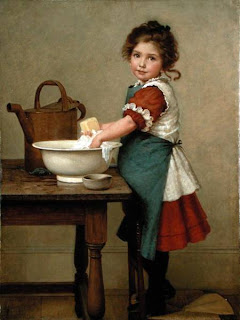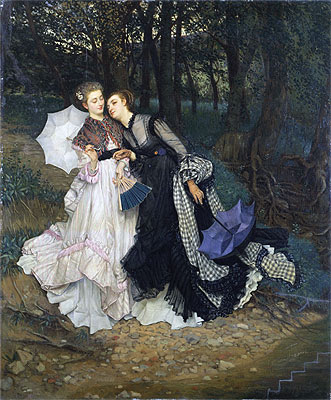Brace yourself.
I rarely have the pleasure of reading a contemporary description of a painting without being familiar with it, but today I read an attack on a work I wasn’t overly conversant with, described as ‘one of those allegorical designs which usually suggest something unwholesome in sentiment…’ (The Times, 1872). Unwholesome? Count me in! You know I like a good dose of corruption. Going further, the Athenaeum pointed out the ‘unmanliness’ ruining the sentiment and both papers had suspicions that the central figure was a corrupting deviation on classical form. Hurrah. Let’s have it then!
 |
| Autumn Love or Love in Autumn (1866) |
Oh. Hang on, I’ll try that again…
 |
| AUTUMN LOVE! LOVE IN AUTUMN! by Simeon Solomon |
Is it just me, or is everyone else underwhelmingly uncorrupted. I expected to immediately fall on my back and roll naked on an animal fur, at the very least. As it is, it’s just a Simeon Solomon picture. No offence, Simeon, but you’ve not corrupted me. Then again, I wonder if you ever really wanted to.
 |
| The Sleepers and the One who Watcheth (1870) |
 |
| Love Among the Ruins Edward Burne-Jones |
I love Simeon Solomon’s work. Recently, Mr Walker hung The Sleepers and the One who Watcheth (1870) in our bedroom, so the first thing I see when I open my eyes in the morning is that gorgeous painting. The painting shows a couple sleeping, while an angel watches over them, their faces all beautiful and peaceful. Although his figures are androgynous (but arguably no more than Burne-Jones), I think the figure in the middle is a woman, the figure on the right is a man, and the figure on the left is an angel, so mind your own business. I also suspect the figure on the right is Gaetano Meo, who modelled for Solomon frequently and was discovered by him playing a harp on the streets of London. He also posed for Burne-Jones’ Love Among the Ruins and Dante’s Dream by Rossetti. If I was less professional I would shout ‘Nom Nom Nom’ and giggle like a schoolgirl, and I wouldn’t be the only one as William Blake Richmond called him ‘the beautiful boy’. So what’s so awful about Love in Autumn?
 |
| Self Portrait (1859) |
It was fine before 1870. Solomon, youngest of a family of artists, showed unusual and precious talent, devoting considerable time to illustrating religious and classical scenes. As his fame grew, his closeness with artists such as Rossetti and Burne-Jones had considerable influence on his work. I was surprised at how much Rossetti contributed as inspiration, until I saw this painting…
 |
| Poetry (1864) |
It has a slightly lighter touch, but Poetry of 1864 reminds me of Rossetti’s pictures of Jane Morris, such as The Blue Silk Dress. The young lady has the look of Jane Morris, but it has been suggested that Jane sat for Simeon during this period. Some of his female figures do bear a remarkable resemblance to her, not least his famous images of Sappho.
 |
| Habeat (1865) |
Look at the variety of women on show in Habeat! (1865) – the golden-haired, thumbs down woman reminds me of a Sandy’s maiden, especially his women who seem to take sexual pleasure in the misery of others, for example Proud Maisie or Medea.
I think it is a shame that modern critics do not hail Simeon’s female portraits as heartily as his male ones, as they are equally as gorgeous. Take for example the different women in A Prelude by Bach (1868).
The lady in blue reminds me so much of Rossetti's Penelope. Contemporary critics saw it as a pretty piece, nothing more, but modern readings note the two women embracing in the background as a symbol of the artist’s own same-sex desire. Now, I’m not saying that’s untrue, but plenty of other artists showed girly action without being gay, so I’m a little dubious. What is true is that the critics picked on the languid beauty of the male figures, and began to hint at an ‘unmanly’ quality to his work. Similar criticisms were understandably levelled at Burne-Jones, whose art most closely resembled Solomon’s style, so why did the mud stick to Simeon and not to Ned?
 |
| Love Amongst the Schoolboys (1865) |
Well, the most obvious answer is that Simeon was gay, and not only that, he gathered patrons who were also gay. His work for Oscar Browning, patron and close friend, was open in its sexuality, such as Love amongst the Schoolboys (1865) and Eton Schoolboys (1867), and determinedly private in their subject, but Solomon’s behaviour had begun to attract attention. His trip to Paris in 1870 was more like a flee, avoiding the trouble that was beginning to follow him. If there were rumours of homosexuality beginning to circulate, his art was seen as proof and the criticism came thick and fast. In 1871, Simeon took a pasting in Robert Buchanan’s Fleshly School of Poetry, along with Rossetti and his other followers. The criticism levelled at Love in Autumn may well have been more knowing than it appeared. A main objection seemed to be that Solomon had chosen a young man to portray Love, rather than a chubby cherub, which Love 'obviously' looks like. There is a sneering hint that Solomon and his patrons would much rather look at the semi-clad young Love (who wouldn’t?) than a fat baby with a bow and arrow, and for that they are obviously ‘unwholesome’. Oddly, the same criticism isn’t levelled at John Roddam Spencer-Stanhope for his painting Love Betrayed where Love is a rather nice looking young man, if a little doomed. Mind your step…
It probably wasn’t a huge surprise when Simeon got arrested with George Roberts doing something naughty in a public loo, although he escaped prison, unlike the unfortunate Mr Roberts. His sentence of 18 months hard labour was reduced to police supervision, but he was ruined and fled London for Devon. The following year, he was caught again, this time in Paris, and this time served three months in prison. He lived another thirty years, but no longer could be openly welcomed by his old friends, plus his behaviour became erratic due to alcohol abuse, however his talent ensures that he is never forgotten or unappreciated, even in his own lifetime. Astonishing, if you consider the weight of prejudice against homosexuality, people continued to trumpet the beauty of Simeon’s work. The Dalziel Brothers used six of his pictures in their Bible Gallery, Five of his paintings appeared in the Royal Jubilee Exhibition of 1887, and Sidney Trefussis Whiteford published an article on Simeon in 1892 entitled ‘A Half-Forgotten Genius’, which led to further offers of work for the artist. Even the inclusion of his paintings among Oscar Wilde’s possessions did not seem to dampen public desire to see his work, and three years after his death, in 1908, Julia Ellsworth Ford published a monograph on his work.
Today, Simeon Solomon is heralded as a gay pioneer, subversively promoting the beauty of men during a period devoted to the female aesthetic. I love the fact that he could infuse a male figure with the same languid beauty as the women, but I worry that his personal circumstances overshadow is genius. By concentrating on his treatment of men, his equally exceptional pictures of women are largely ignored. The way I look at it is this: I think his brilliant portrayal of men isn’t to do with his sexuality as much as it is to do with his talent as an artist. Sometimes I feel that modern biography is often a case of making the story fit the ending. If you didn’t know that Simeon was gay, would you guess from his art? Maybe you’d guess, but look again at Burne-Jones or Leighton and think if the same judgement can be made of them. Maybe we could also celebrate Simeon Solomon for things he had a choice in: his bravery, his uncompromising use of art and his talent for gentle beauty.
Who wouldn’t want to wake up to that every morning?























































